The Science Behind the Calico Cat's Colours

Calico cat (AnthonyRosenberg, iStockphoto)

Calico cat (AnthonyRosenberg, iStockphoto)
How does this align with my curriculum?
| Grade | Course | Topic |
|---|
The patchwork fur colour of Calico and tortoiseshell cats is an interesting case of genetics, heredity and sex-linked traits.
People love cats! And they are not just popular in Canada. There are millions of cat videos that can be found on YouTube from all over the world!
Did you know?
Cats can make us laugh, they can make good family pets, or they may even scare some of us. But did you know that the fur of some cats can be useful in understanding the branch of genetics called epigenetics? Epigenetics is the study of changes in gene expression due to factors other than changes to DNA. We can look at tortoiseshell and calico cats to understand this a little better.
How do your sex chromosomes affect your cells?
Most of us get one sex chromosome from each parent. There are two types of sex chromosomes known as X chromosomes and Y chromosomes. If you’re biologically female, you most likely got an X chromosome from each parent. If you’re biologically male, you most likely got an X chromosome from your mother and a Y chromosome from your father.
Did you know?
Even though XX and XY are the two most common chromosomal combinations, others are possible. Women with Turner syndrome have only one chromosome (X). Men with Klinefelter syndrome have two X chromosomes and one Y chromosome (XXY).
Certain genes are found on the X chromosome. While others are found on the Y chromosome. If you’re biologically male, then each of your cells get instructions from both chromosomes. But if you’re biologically female, things work a little differently. Your cells cannot get their instructions from two different X chromosomes. Because of this, one x chromosome needs to be inactivated in every cell of your body.
Did you know?
The X-Y chromosome system can be found in most mammals, some insects, and even some types of plants!
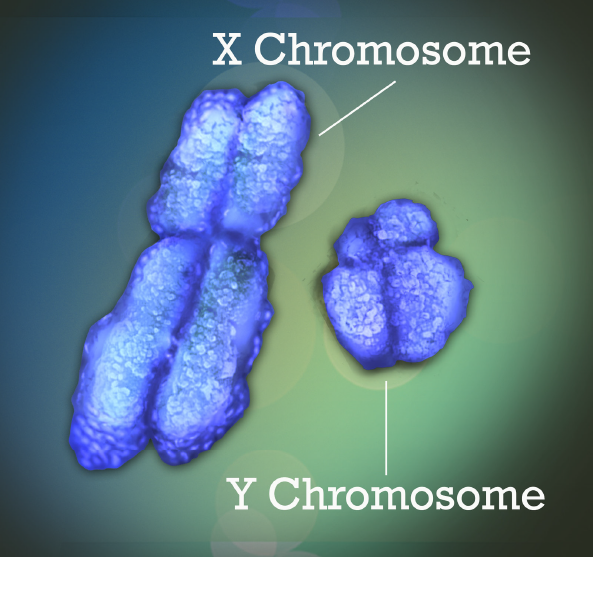
How does the body know which chromosome is active?
During the embryonic development of every female mammal, one of the X chromosomes in each cell becomes inactive. This process is known as lyonization.
An X chromosome becomes inactive by curling itself up into a tight mass called a Barr body. Because it is curled up, its genes cannot be expressed. Only the genes on the active, or uncoiled, X chromosome are expressed. This means that the genetic information of active X chromosomes is what causes the physical traits we see. Eye colour and hair colour are examples of these physical traits.
Lyonization is random in each cell, so there is no way to predict which of the X chromosomes will be active. Therefore, any given cell of a female could end up expressing traits from either of the X chromosomes.
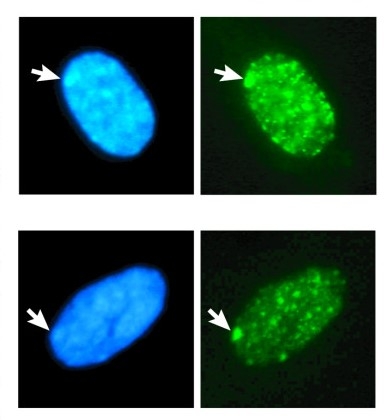
How do tortoiseshell cats get their colours?
Let’s get back to cats! You may be familiar with the interesting pattern of orange and black found on tortoiseshell cats. This colouring has to do with genes on the X chromosome.
Like humans, cats have X and Y chromosomes that determine their biological sex. Cats get one of these chromosomes from each parent. A cat with two X chromosomes is female. A cat with an X and a Y chromosome is male.
In cats, the X chromosome carries a gene for fur colour. In tortoiseshell cats, there are two versions, or alleles, of this gene. One is for orange fur (XB). The other is for black fur (Xb). This means that any cell in a female cat could have the combination XBXB, XBXb or XbXb.
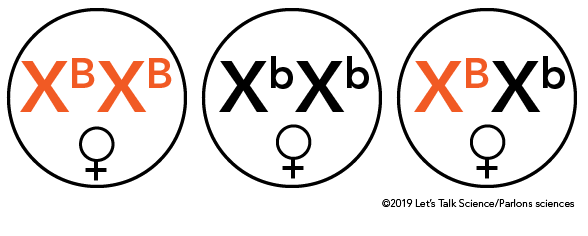
If a female cat gets two XB alleles from her parents, her fur will be orange. If a female cat gets two Xb alleles from her parents, her fur will be black. However, it is uncommon for female cats to receive two of the same alleles for fur colour from their parents.
Solid orange and solid black fur is much more common in male cats. This is because they only have one X chromosome. So they either have the allele for orange or brown.
Things get interesting when a female cat gets an XB allele from one parent and an Xb allele from the other parent. That’s when you get a cat with orange and black patches, like a tortoiseshell!
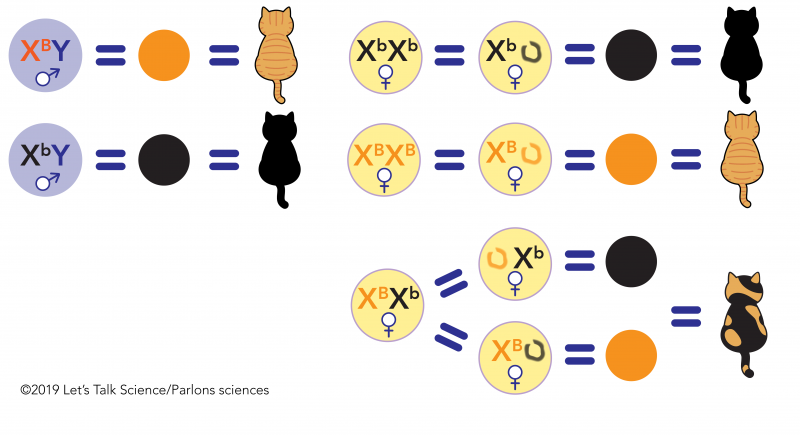
How does a tortoiseshell get its pattern?
Of course, tortoiseshell cats aren’t just half black and half orange. In the cells of a kitten embryo, one of the X chromosomes will be active and one will be inactive. So, each cell will express either the XB or Xb allele. Which allele it expresses is totally random. As the kitten grows, its skin cells will divide again and again. The cells with each type of allele will spread throughout the cat’s skin, resulting in a unique pattern.
Did you know?
Male tortoiseshell and calico cats are rare, but they do exist. Can you guess what a male’s sex chromosome makeup would need to be? If you said XXY - you’re right!

What is the difference between a tortoiseshell and calico?
Calicos differ from tortoiseshell cats because they have patches of white as well as patches of orange and black. This is because calico cats have a genetic condition called piebalding. A piebald animal has patches of white skin or fur. This is controlled by a gene that affects a skin cell’s ability to produce the pigment that causes colour.
The white patches of a calico may be large, or small and mixed in with the black and orange. Typically, the larger the white patches, the less the orange and brown fur colours will mix. This is why calico cats with large patches of white fur tend to have distinct patches of orange and black.
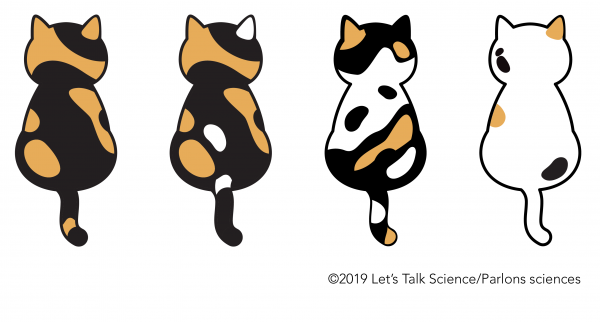
Tortoiseshell and calico cats are not just pretty to look at and fun to have as pets. They are also amazing examples of epigenetics in action!
Starting Points
- Have you ever seen a calico or tortoiseshell cat? How is its coloration different from other cats?
- Have you ever noticed that some physical features (e.g., calico coloration) are only visible in a male or female animal? If so, what features have you noticed?
- How does knowledge of x chromosome inactivation help researchers explore activation of other chromosomes or genes? Explain.
- What impacts might occur if epigenetic research determined that eating a certain food would activate genes that prevented a person from developing cancer? Explain.
- Research examples of where animals are bred for their unusual colouration.
- What is an epigenetic gene?
- In what ways are x chromosomes different from y chromosomes?
- Why does x chromosome inactivation occur? What structure is formed from x chromosome inactivation?
- Why are male calico or tortoiseshell cats rare?
- Complete a Punnett square to determine the probability of a black male and an orange female having tortoiseshell (orange and black) offspring.
- There are many iconic cats featured in cartoons, films, commercials and literature. Can you think of any that are calico cats or tortoiseshell cats? How is coat colour used to define the cat’s character, background or social status? (e.g., Garfield, Morris the Cat, Silvester, the Cheshire Cat, the cats of TS Eliot’s poetry, Si and Am from Lady and the Tramp, toilet paper kittens, etc.)
- This article can be used to support teaching and learning of Biology and Genetics related to DNA structure and heredity. Concepts introduced include genetics, epigenetics, sex chromosome, X chromosomes, Y chromosomes, inactivated, lyonization, Barr body, physical traits, alleles and piebalding.
- Before reading this article, teachers could begin by introducing the concepts of sex chromosomes and sex-linked inheritance. This article could also serve as an introduction to the topic of sex-linked traits and disorders in humans. (e.g., hemophilia, Duchenne's Muscular Dystrophy, etc.)
- Prior to reading the article, teachers could also have students use a Vocabulary Preview learning strategy to engage their prior knowledge and introduce new terminology. Ready-to-use Vocabulary Preview reproducibles for this article are available in [Google doc] and [PDF] formats.
- After reading the article, teachers could use a Key Ideas Round Robin learning strategy to help students focus on the key points of the article and consolidate new information. Ready-to-use Key Ideas Round Robin reproducibles for this article are available in [Google doc] and [PDF] formats.
- As a STSE extension of this topic, teachers could have students consider if the colour of a cat matters by exploring the stereotypes, biases, discrimination and advantages associated with coat colour, through classroom discussion or using a Silent Discussion/Graffiti learning strategy. Ready-to-use Silent Discussion / Graffiti reproducibles for this article are available in [Google doc] and [PDF] formats.
Connecting and Relating
- Have you ever seen a calico or tortoiseshell cat? How is its coloration different from other cats?
- Have you ever noticed that some physical features (e.g., calico coloration) are only visible in a male or female animal? If so, what features have you noticed?
Relating Science and Technology to Society and the Environment
- How does knowledge of x chromosome inactivation help researchers explore activation of other chromosomes or genes? Explain.
- What impacts might occur if epigenetic research determined that eating a certain food would activate genes that prevented a person from developing cancer? Explain.
- Research examples of where animals are bred for their unusual colouration.
Exploring Concepts
- What is an epigenetic gene?
- In what ways are x chromosomes different from y chromosomes?
- Why does x chromosome inactivation occur? What structure is formed from x chromosome inactivation?
- Why are male calico or tortoiseshell cats rare?
- Complete a Punnett square to determine the probability of a black male and an orange female having tortoiseshell (orange and black) offspring.
Media Literacy
- There are many iconic cats featured in cartoons, films, commercials and literature. Can you think of any that are calico cats or tortoiseshell cats? How is coat colour used to define the cat’s character, background or social status? (e.g., Garfield, Morris the Cat, Silvester, the Cheshire Cat, the cats of TS Eliot’s poetry, Si and Am from Lady and the Tramp, toilet paper kittens, etc.)
Teaching Suggestions
- This article can be used to support teaching and learning of Biology and Genetics related to DNA structure and heredity. Concepts introduced include genetics, epigenetics, sex chromosome, X chromosomes, Y chromosomes, inactivated, lyonization, Barr body, physical traits, alleles and piebalding.
- Before reading this article, teachers could begin by introducing the concepts of sex chromosomes and sex-linked inheritance. This article could also serve as an introduction to the topic of sex-linked traits and disorders in humans. (e.g., hemophilia, Duchenne's Muscular Dystrophy, etc.)
- Prior to reading the article, teachers could also have students use a Vocabulary Preview learning strategy to engage their prior knowledge and introduce new terminology. Ready-to-use Vocabulary Preview reproducibles for this article are available in [Google doc] and [PDF] formats.
- After reading the article, teachers could use a Key Ideas Round Robin learning strategy to help students focus on the key points of the article and consolidate new information. Ready-to-use Key Ideas Round Robin reproducibles for this article are available in [Google doc] and [PDF] formats.
- As a STSE extension of this topic, teachers could have students consider if the colour of a cat matters by exploring the stereotypes, biases, discrimination and advantages associated with coat colour, through classroom discussion or using a Silent Discussion/Graffiti learning strategy. Ready-to-use Silent Discussion / Graffiti reproducibles for this article are available in [Google doc] and [PDF] formats.
Learn more
Why Is The Internet Obsessed With Cats? (2019)
An article by Cynthia Lopez for Pet Life Today containing an infographic discussing why the internet is obsessed with cats: from cat videos, to feline celebrities, to people who make money off their cats!
7 Genes That Control Your Cat’s Fur Color (2012)
An article by Jane A Kelley for Catster listing the 7 different genes that result in the many different cat-fur colour combinations you may recognize.
Why Women Are Stripey (2014)
A video (5:16 min.) from Veritasium explaining DNA and chromosomes, they way sex-chrmosomes are distributed, and how the inactivation in genes can be responsible for how different traits are expressed. Note that this resource was also used as a reference.
Calico Cats: The Science Behind Their Colors (2018)
A video (3:15 min.) from Critter Crusades explaining how sex-linked chromsomes can result in the genetic expression of cat fur colour, especially in the unique instance of calico cats. Note that this resource was also used as a reference.
References
Anoop, U. R., Ramesh, V., Balamurali, P. D., Nirima, O., Premalatha, B., & Karthikshree, V. P. (2004). Role of Barr bodies obtained from oral smears in the determination of sex. Indian Journal of Dental Research, 15(1), 5-7.
Hartwell, S. (2016). Tortoiseshell and tri-color cats. Messy Beast.
Kremples, D. M. (n.d.). The genetics of calico cats. University of Miami.
Soellner, J. (2017, September 1). Do all organisms have the "X" and "Y" chromosome configuration? Quora.
Szalay, J. (2017, December 9). Chromosomes: Definition & structure. Live Science.